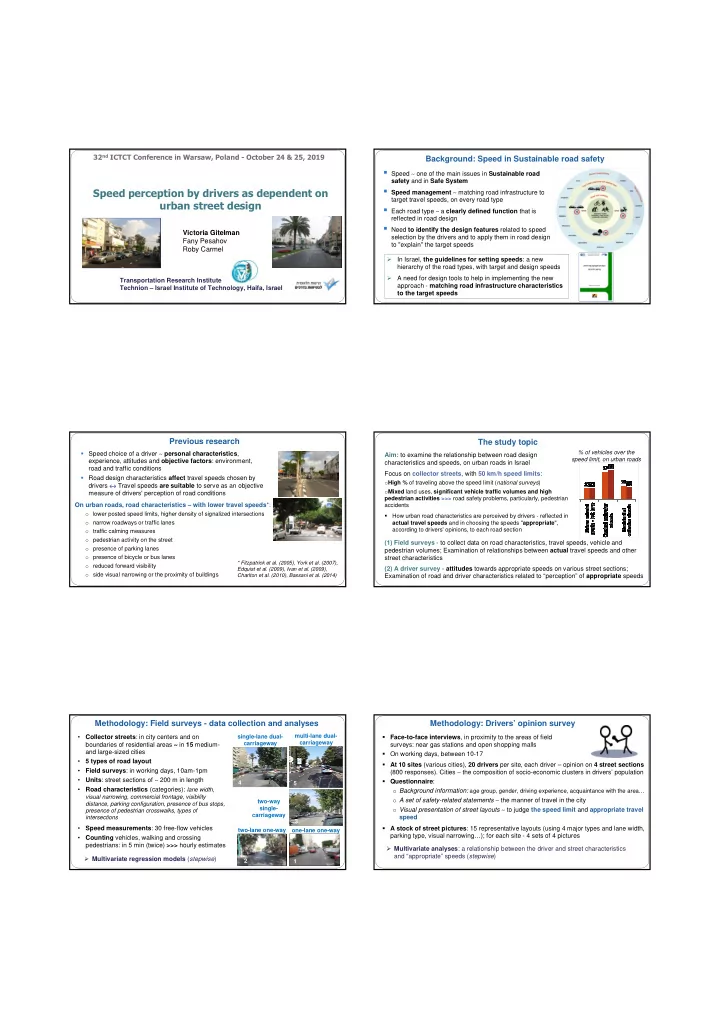

32 nd ICTCT Conference in Warsaw, Poland - October 24 & 25, 2019 Background: Speed in Sustainable road safety � Speed ∼ one of the main issues in Sustainable road safety and in Safe System � Speed management ∼ matching road infrastructure to Speed perception by drivers as dependent on target travel speeds, on every road type urban street design � Each road type ∼ a clearly defined function that is reflected in road design � Need to identify the design features related to speed Victoria Gitelman selection by the drivers and to apply them in road design Fany Pesahov to "explain" the target speeds Roby Carmel � In Israel, the guidelines for setting speeds : a new hierarchy of the road types, with target and design speeds � A need for design tools to help in implementing the new Transportation Research Institute approach - matching road infrastructure characteristics Technion – Israel Institute of Technology, Haifa, Israel to the target speeds Previous research The study topic � Speed choice of a driver ∼ personal characteristics , % of vehicles over the Aim: to examine the relationship between road design speed limit, on urban roads experience, attitudes and objective factors : environment, characteristics and speeds, on urban roads in Israel road and traffic conditions Focus on collector streets , with 50 km/h speed limits : � Road design characteristics affect travel speeds chosen by o High % of traveling above the speed limit ( national surveys ) drivers ↔ Travel speeds are suitable to serve as an objective o Mixed land uses, significant vehicle traffic volumes and high measure of drivers' perception of road conditions pedestrian activities >>> road safety problems, particularly, pedestrian On urban roads, road characteristics ∼ with lower travel speeds *: accidents o lower posted speed limits, higher density of signalized intersections � How urban road characteristics are perceived by drivers - reflected in o narrow roadways or traffic lanes actual travel speeds and in choosing the speeds " appropriate ", according to drivers' opinions, to each road section o traffic calming measures o pedestrian activity on the street (1) Field surveys - to collect data on road characteristics, travel speeds, vehicle and o presence of parking lanes pedestrian volumes; Examination of relationships between actual travel speeds and other o presence of bicycle or bus lanes street characteristics * Fitzpatrick et al. (2005), York et al. (2007), o reduced forward visibility (2) A driver survey - attitudes towards appropriate speeds on various street sections; Edquist et al. (2009), Ivan et al. (2009), o side visual narrowing or the proximity of buildings Charlton et al. (2010), Bassani et al. (2014) Examination of road and driver characteristics related to “perception” of appropriate speeds Methodology: Field surveys - data collection and analyses Methodology: Drivers’ opinion survey • Collector streets : in city centers and on single-lane dual- multi-lane dual- � Face-to-face interviews , in proximity to the areas of field boundaries of residential areas ∼ in 15 medium- carriageway carriageway surveys: near gas stations and open shopping malls and large-sized cities � On working days, between 10-17 • 5 types of road layout � At 10 sites (various cities), 20 drivers per site, each driver – opinion on 4 street sections • Field surveys : in working days, 10am-1pm (800 responses). Cities ∼ the composition of socio-economic clusters in drivers’ population Units : street sections of ∼ 200 m in length • � Questionnaire : 4 5 • Road characteristics (categories): lane width, o Background information: age group, gender, driving experience, acquaintance with the area… visual narrowing, commercial frontage, visibility o A set of safety-related statements ∼ the manner of travel in the city two-way distance, parking configuration, presence of bus stops, single- o Visual presentation of street layouts ∼ to judge the speed limit and appropriate travel presence of pedestrian crosswalks, types of carriageway intersections speed 3 � A stock of street pictures : 15 representative layouts (using 4 major types and lane width, • Speed measurements : 30 free-flow vehicles two-lane one-way one-lane one-way parking type, visual narrowing…); for each site - 4 sets of 4 pictures • Counting vehicles, walking and crossing pedestrians: in 5 min (twice) >>> hourly estimates � Multivariate analyses : a relationship between the driver and street characteristics and “appropriate” speeds ( stepwise ) � Multivariate regression models ( stepwise ) 2 1
Recommend
More recommend